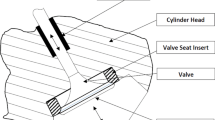Abstract
The wear of engine valve and seat insert is one of the most important factors which affect engine performance. Because of higher demands on performance and the increasing use of alternative fuel, engine valve and seat insert are challenged with greater wear problems than in the past. In order to solve the above problems, a simulator was developed to be able to generate and control high temperatures and various speeds during motion. The wear simulator is considered to be a valid simulation of the engine valve and seat insert wear process with various speeds during engine activity. This work focuses on the different degrees of wear at three different singular test speeds (10 Hz, 25 Hz & multi-Hz). For this study, the temperature of the outer surface of the seat insert was controlled at 350°C, and the test load was 1960 N. The test cycle number was 6.0×106. The mean (±standard error) wear depth of the valve at 10 Hz and 25 Hz was 45.1 (±3.7)μm and 81.7 (±2.5)μm, respectively. The mean wear depth of the seat insert at 10 Hz and 25 Hz was 52.7 (±3.9) μm and 91.2 (±2.7) μm, respectively. In the case of multi-Hz it was 70.7 (±2.4)/on and 77.4 (±3.8) μm, respectively. It was found that higher speed (25 Hz) cause a greater degree of wear than lower speed (10 Hz) under identical test condition (temperature, valve displacement, cycle number and test load). In the wear mechanisms of valves, adhesive wear, shear strain and abrasive wear could be observed. Also, in the wear mechanisms of seat inserts, adhesive wear, surface fatigue wear and abrasive wear could be observed.
Similar content being viewed by others
References
Chun, K. J., Hong, J. S., Lee, H. J., Kim, D. Y. and Im, J. K., 2004, “A Study on Engine Valve and Seat Insert Wearing Depending on Speed Change,” SAE Paper 2004-01-16.
Dissel, R. van, Barber, G. C., Larson, J. M. and Naraslmhan, S. L., 1989, “Engine Valve Seat and Insert Wear,” SAE Paper 892146.
Fujiki, A. and Kano, M., 1992, “New PM Seat Insert Materials for High Performance Engines,” SAE Paper 920570.
Kim, G. S., Lee, I. C. and Jeong, I. S., 1999, “Fine Constitution and Mechanical Properties of Sintered seat insert for Gasoline Engine Depending on Ni and Mo Contents,”Korea Metal Society Journal, Vol. 37, No. 6, pp. 694–699.
Lewis, R., Dwyer-Joyce, R. S. and Josey, G., 1999, “Investingation of Wear Mechanisms Occurring in Passenger Car Diesel Engine Inlet Valve and Seat Insert,” SAE Paper 1999-01-1216.
Ootani, T., Yahata, N., Fujiki, A. and Ehira, A., 1995, “Impact Wear Characteristics of Engine Valve and seat Insert Insert Materials at High Temperature (impact Wear Tests of Austenitic Heat-Resistant Steel SUH36 against Fe-Base Sintered Alloy Using Plane Specimens),” Wear 188, pp. 175–184.
Pyle, W. R. and Smrcka, N. R., 1993, “The Effect of Lubricating Oil Additive on Valve Recession in Stationary Gaseous-Fueled Four-Cycle Engine,” SAE 932780.
Sato, K., Midorikawa, T., Takahashi, T. and Oshige, H., 2000, “Development of Seat Insert Material for Gas-Fueled Engines”, SAE Paper 2000-01-0911.
Scott, C. G., Riga, A. T. and Hong, H., 1995, “The Erosion-Corrosion of Nickel-Base Diesel Engine Exhaust Valves,” Wear 181–183, pp. 485–494.
Zhao, R., Barber, G. C., Wang, Y. S. and Larson, J. E., 1997, “Wear Mechanism Analysis of Engine Exhaust Valve Seats with a Laboratory Simulator,” STLE, Vol. 40, No. 2, pp. 209–218.
Author information
Authors and Affiliations
Corresponding author
Rights and permissions
About this article
Cite this article
Hong, J.S., Chun, K.J. & Youn, Y.H. A study on wear and wear mechanism of exhaust valve and seat insert depending on different speeds using a simulator. J Mech Sci Technol 20, 2052–2060 (2006). https://doi.org/10.1007/BF02916322
Received:
Revised:
Issue Date:
DOI: https://doi.org/10.1007/BF02916322




